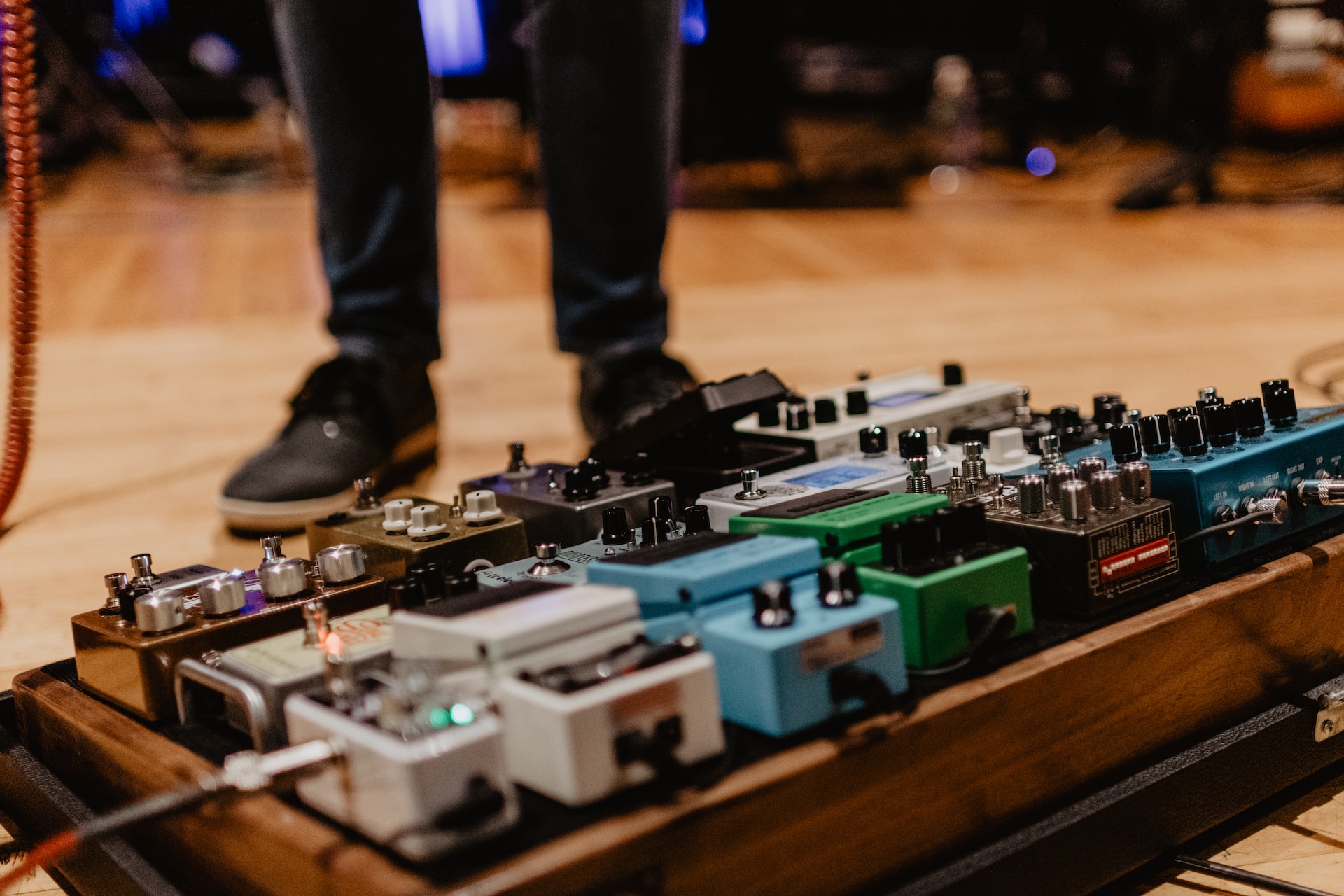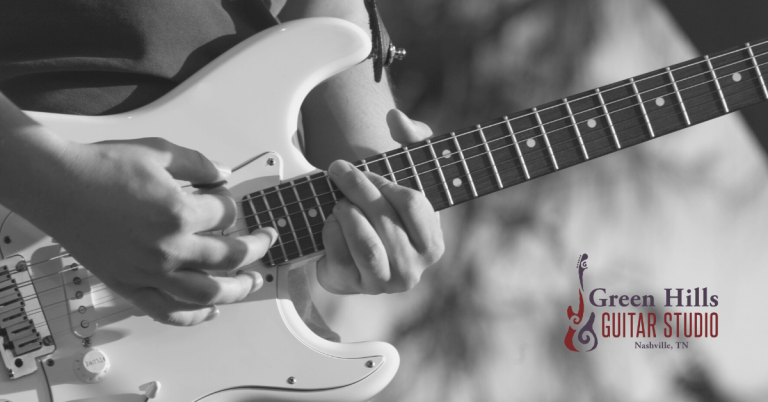Navigating the World of Guitar Effects Pedals
Step into the sonic realm of guitar effects pedals—the magical boxes that mold your guitar’s sound while lightening your wallet. Guitar pedals can help you craft tones and textures to inspire new musical landscapes.
If you’re looking for the gritty growl of distortion, the wooly warmth of fuzz, or the expansive ambiance of reverbs and delays, each pedal is capable of adding a distinctive tonal color to your sonic palette.
In this guide, we’re going to demystify the complexity surrounding effects pedals and make the decision-making process straightforward.
Whether you’re a new student taking your first foray into guitar pedals or a seasoned player seeking fresh inspiration, join us in unraveling the art of crafting sound with guitar effects pedals.
Understanding the Basics of Guitar Effects Pedals
Let’s break down the basics of guitar effects pedals. These little devices have a big impact on how your guitar sounds. Picture them as tools that tweak and enhance your guitar’s natural sound.
They work by changing the electrical signal from your guitar and adding effects to create different tones. For example, distortion gives a rough edge, reverb adds a spacious feel, and modulation introduces tonal variations.
Understanding these basics is like unlocking a toolbox of creative possibilities. It lets you shape the sound of your guitar to match your musical style.
Now let’s walk you through the different types of guitar pedals and their essential functions, so you can explore the world of effects and find new ways to inspire your sound.
Types of Guitar Pedals
Let’s explore the different types of guitar pedals and how they can shape your sound. Each category has a unique impact, from modulation to time-based effects and dynamic to pitch-based manipulations.
1. Gain Pedals
Gain-based effects play a crucial role in altering your guitar’s tone. Let’s break down three main types:
Distortion Pedals:
Ideal for rock enthusiasts, distortion pedals add a powerful growl to your guitar sound. They create a gritty and intense tone, perfect for unleashing impactful riffs.
Overdrive Pedals:
Offering a smoother touch, overdrive pedals are great for bluesy and nuanced playing. They add a subtle edge to your tone without overwhelming the clarity, making them versatile for various musical styles.
Fuzz Pedals:
Fuzz pedals are the go-to if you want a thick and saturated sound. They create an intense wall of sound, perfect for genres where a bold sonic presence is desired.
2. Modulation Effects
Modulation effects introduce dynamic textures to your guitar’s sound. Let’s explore four key types:
Chorus Pedals:
Chorus adds a shimmering, doubled effect, enhancing your sound with a spacious and rich quality. Perfect for achieving a fuller, ensemble-like tone.
Flanger Pedals:
Flanger produces a distinctive sweeping sound, creating a whooshing effect. Ideal for adding a touch of movement and vibrato to your playing.
Phaser Pedals:
Phaser imparts a swirling, phased tone reminiscent of a sweeping jet plane. Enhance your sound with a psychedelic touch and spatial depth.
Tremolo Pedals:
Tremolo delivers rhythmic volume fluctuations, adding pulsating dynamics to your playing. Ideal for achieving vintage vibes and expressive playing.
3. Time-Based Effects
Time-based effects contribute to the temporal dimension of your guitar’s sonic landscape. Let’s explore two primary types:
Delay Pedals:
Delay pedals reproduce your guitar’s sound after a set time, creating echoes that add depth and dimension. Perfect for achieving spacious and atmospheric tones and creating rhythmic patterns.
Reverb Pedals:
Reverb simulates the acoustic characteristics of different spaces, adding a sense of room or ambiance to your sound. Ideal for creating a lush, immersive environment and enhancing sustain.
4. Filter-Based Effects
Enter the world of filter-based effects, shaping your guitar’s tone in unique ways. Let’s explore two primary types:
Wah-Wah Pedals:
Wah-Wah pedals modulate the guitar’s tone by emphasizing specific frequencies, creating a distinctive “wah” sound. They are ideal for expressive, vocal-like effects and respond dynamically to your playing style.
Envelope Filter Pedals:
Envelope filter pedals dynamically adjust the tone based on your playing attack. They produce dynamic, funky sounds often associated with genres like funk and R&B, adding a responsive and expressive element to your playing.
5. Filter-Based Effects
Discover the impact of dynamic effects on shaping your guitar’s tonal nuances. Let’s explore two key types:
Compressor Pedals:
Compressor pedals even out your guitar’s volume, enhancing sustain and providing a consistent sound. Ideal for smoothing out playing dynamics and adding sustain to your notes.
EQ Pedals:
EQ pedals allow you to adjust the frequency response of your guitar, shaping the overall tone. Ideal for fine-tuning your sound by boosting or cutting specific frequencies to suit different playing environments.
6. Pitch-Based Effects
Embark on a sonic journey with pitch-based effects, elevating your guitar’s sound to new heights. Let’s explore two essential types:
Pitch Shifter Pedals:
Pitch shifters modify the pitch of your guitar, allowing you to create harmonies, simulate multiple instruments, or achieve unconventional sounds. Ideal for adding depth and complexity to your playing.
Octave Pedals:
Octave pedals generate tones one or more octaves above or below your original pitch. Whether seeking a fuller sound or exploring experimental tones, octave pedals offer versatility for various musical styles.
Tips on Creating Unique Tones
Ready to carve out your signature sound? Here’s your guide to experimenting and refining your unique tones.
Experimentation and Exploration
Don’t be afraid to try various pedal combinations. Experiment with stacking different effects to discover new textures and tones.
Explore Your Style:
Your playing style is unique – embrace it. Experiment with pedals that resonate with your musical preferences. Find what complements your playing, whether it’s bluesy bends or heavy riffs.
Understanding Signal Chain
Your signal chain is the order in which your pedals are connected. It significantly affects your overall tone.
Impact on Tone:
The order of your pedals matters. Placing a distortion pedal before a delay, for instance, produces a different result than the reverse. Experiment to find what arrangement suits your desired sound.
Tips for Arranging Your Pedals:
- Start with essentials like tuner and compression early in the chain.
- Place time-based effects (delay, reverb) towards the end for a cleaner signal.
- Experiment with modulation and gain-based effects in between to find a balanced arrangement.
Remember, there’s no one-size-fits-all rule. Your signal chain is personal, and what works for one may not work for another. The key is to experiment, trust your ears, and enjoy the experimental journey of crafting your distinctive tones.
The Coda
In conclusion, crafting your unique sound with guitar effects pedals is an exciting journey. Remember to experiment with different pedal combinations so you understand how they enhance your playing style.
Understand the impact of signal chain order to fine-tune your tones. Embrace the creative possibilities – whether into powerful riffs or subtle melodies.
If you’re ready to take your guitar skills to the next level, connect with Green Hills Guitar Studio. Whether online or in-person in Nashville, TN, we offer private lessons to help you master your musical craft. Happy playing!






